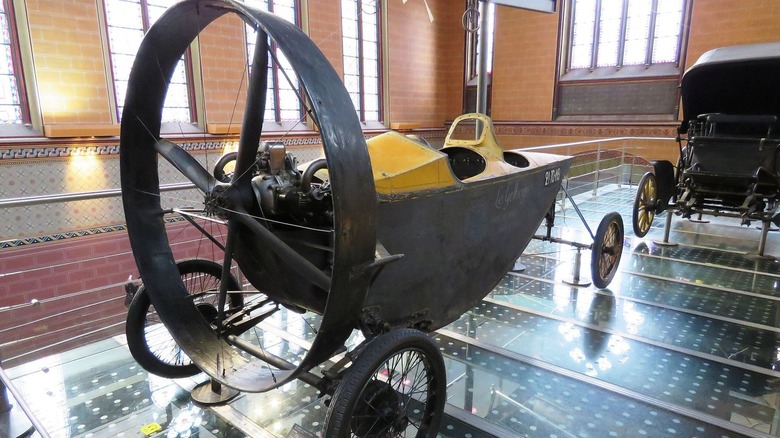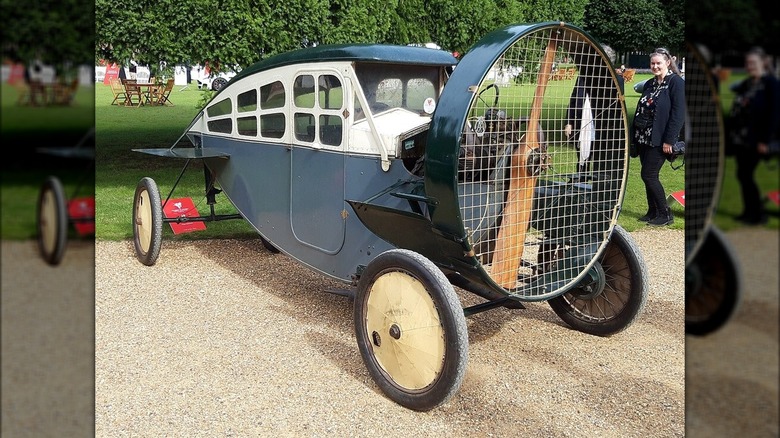Automobile Or Airplane: What Was The Propeller-Powered Leyat Hélica?
The year is 1909. Marcel Leyat, a young Frenchman with an engineering degree, was putting the finishing touches on his first scratch-built airplane. He began his aviation career crafting biplane wings, which is ironic given that he would end up creating a vehicle without wings. Not long after successfully getting his first plane into the air, he realized that perhaps he could take the knowledge gleaned from building planes and create a better automobile.
One must remember the time and place that was the turn of the century in the early 1900s when both cars and planes were still fancy new bits of tech. The first "vehicle powered by a gas engine" was patented by Carl Benz in 1886. Henry Ford's first mass-produced car (the Model T) was released in 1908, and Daimler Motoren Gesellschaft was making roughly a thousand cars a year at its factory in Germany by 1909. Meanwhile, the Wright brothers had taken to the air and flew into aviation history near Kitty Hawk, North Carolina, in 1903, just a few years prior to Leyat's leap into the air. The world was changing — quickly.
Not long after getting his plane into the air in 1909, he began working on his first design for a propeller-driven automobile, which he finished in 1913. The monocoque body was made from plywood and weighed a mere 550 pounds, light enough to be powered by a 1,000 cc, 18-horsepower Harley-Davidson V-twin engine.
[Featured image by Lomita via Wikimedia Commons | Cropped and scaled | CC BY-SA 4.0]
A propeller was a bold choice
Over the next several years, Leyat tested and refined that initial design until he came up with a working production model in 1919. He named his new contraption Hélica, as "hélice" was the French word for propeller. One of the main tenets behind his design was to create power and turn it into motion in the simplest way possible.
Leyat felt that by making the car aerodynamic using curved panels that very much resembled the body of an airplane, he could reduce drag and minimize wind resistance. He also believed cars, in general, were overly complex with transmissions, clutches, drive shafts, and the like, all of which made automobiles incredibly heavy. Even later Hélica models only weighed 625 pounds, resulting in much better gas mileage.
Being a trained aviation designer by trade, Leyat shunned the traditional gas-powered engine for a propeller that would pull the vehicle along instead of pushing it down the road — the exact opposite of "Molt" Taylor's flying Aerocar (with its rear-mounted propeller) from the 1940s. Leyat's theory about the internal mechanics reduced weight and made it easier to build and maintain, but other issues made it a terrible choice.
The Hélica initially had a fully exposed wooden propeller, posing a massive safety issue to bystanders and birds alike. Imagine the resultant mess caused by a bird flying into (and through) the propeller. A wire mesh was added later to keep wayward fowl and fingers out.
A plane without wings
Next, those first versions had an open-air cockpit where the occupants were constantly bombarded by propeller wash. To eliminate the problem, he enclosed the driver and passengers, making the body look even more like the fuselage of a modern airplane. Unfortunately, none of those changes fixed two other problems caused by the big spinning death blade up front.
First, if the Hélica rear-ended another car, the propeller could explode, sending shrapnel in all directions. Secondly, there was the simple matter of that very same big spinning death blade up front blocking the driver's view. OF course, let's not forget the noise. If you thought early automobiles were loud (and they were), it was nothing compared to the noise created by the propeller-powered Hélica.
To further cut down on the vehicle's overall weight (and drag), Leyat ditched spoked wheels for aluminum discs and integrated the brakes. The car turned using a cable-operated rear-wheel steering system that pivoted the rear sideways.
The concept of "rear-wheel steering" was way ahead of its time and would linger around for decades but not become fully embraced until the late 1970s when Porsche used a mechanical Weissach axle in the 928 grand tourer, perhaps the most underrated Porsche of all time. In 1985, Nissan dropped the first active rear-wheel steering in its R31 Skyline.
[Featured image by MrWalkr via Wikimedia Commons | Cropped and scaled | CC BY-SA 4.0]
Leyat ushered in new thinking
In 1921, the Hélica debuted at the Paris Auto Show, and the response was quite positive. According to reports, Leyat had inquiries from as many as 600 interested parties. Regrettably (or perhaps luckily), he couldn't obtain funding to mass-produce the propped wonder. Sources vary, but it's estimated that between 1919 and 1926 Leyat only managed to build between 25 and 30 of his planes without wings.
Interestingly, a Hélica was recorded hitting a top speed of 106 miles per hour in 1927. By comparison, the top speed of a Model T of the day was only about 45 miles per hour.
While the Hélica faded into obscurity, other inventive designers believed propeller-powered cars were the future. Considering we have none today, it seems that was a misguided notion. However, Leyat's designs did bring automotive aerodynamics to the forefront of a fledgling industry and shed new light on exactly how a car could be built.

